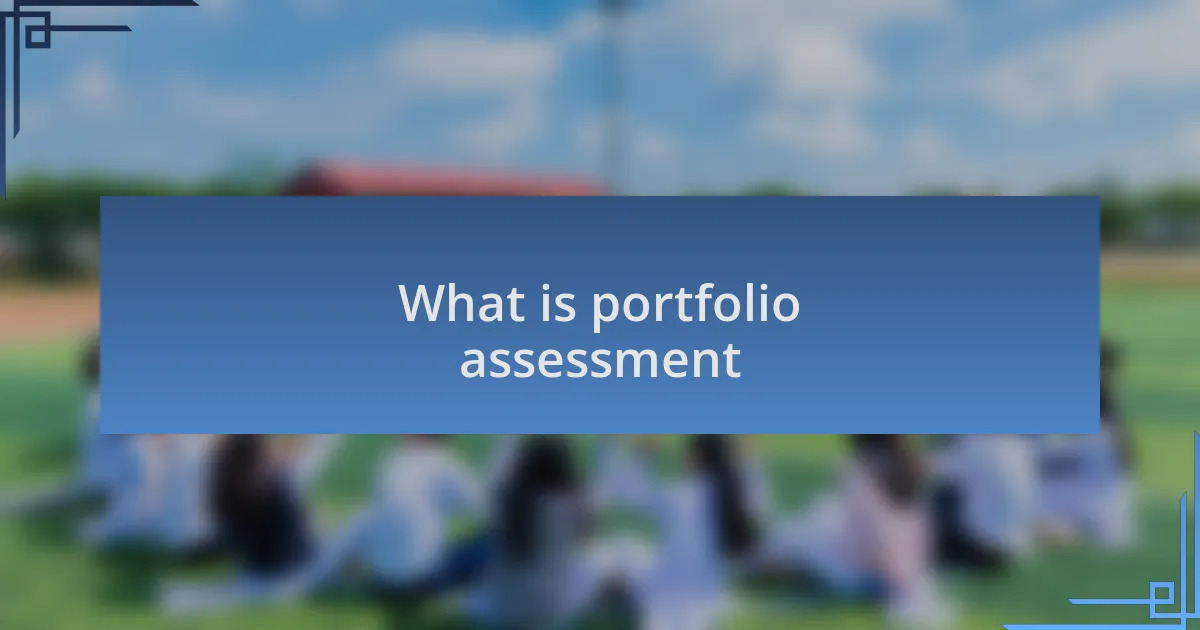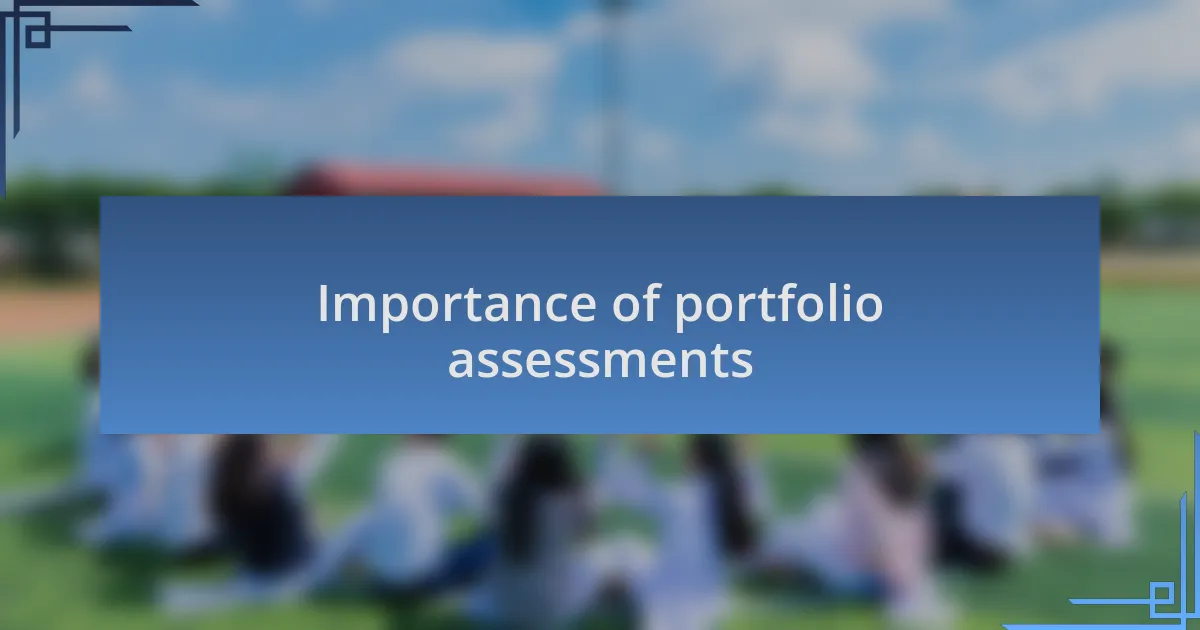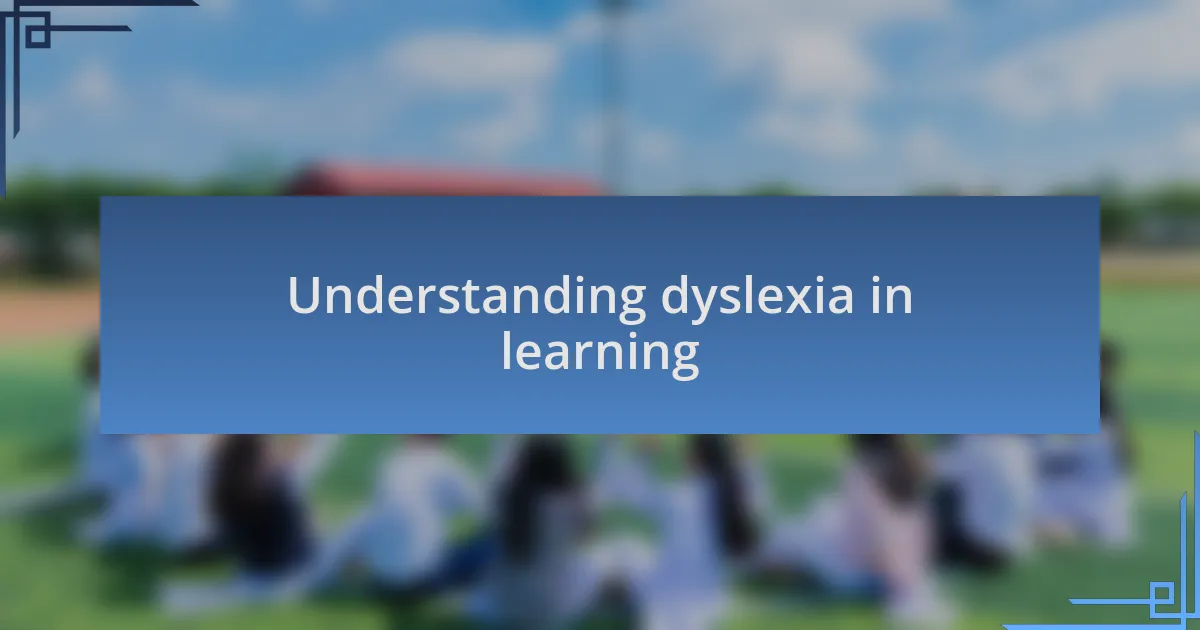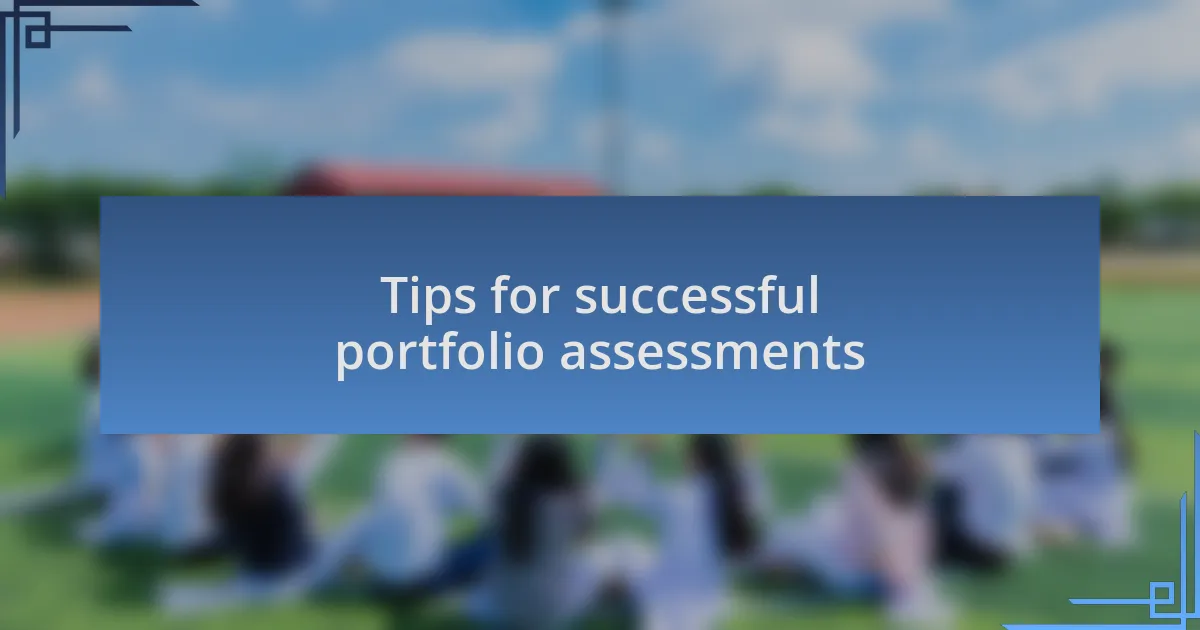Key takeaways:
- Portfolio assessments provide a holistic understanding of student learning, showcasing individual strengths beyond traditional tests.
- They foster self-reflection and goal-setting, enhancing students’ confidence and ownership of their learning experiences.
- Effective strategies for supporting students with dyslexia, such as structured literacy techniques and assistive technology, significantly improve their learning outcomes.
- Parental involvement and a supportive environment are crucial for the success of portfolio assessments and dyslexia training.

What is portfolio assessment
Portfolio assessment is a method that collects a range of student work to demonstrate learning over time. In my experience, it allows students to showcase their strengths and progress in a more holistic manner, rather than relying solely on standardized tests. Have you ever noticed how traditional tests can miss the nuances of a student’s capabilities?
As I review portfolios, I often find pieces that reveal the unique voice of each learner—artwork, writing samples, and reflections that tell their individual stories. It’s fascinating to see how a student might struggle with reading but excel in creative expression, offering a deeper understanding of their learning journey. Isn’t it powerful to think that assessments can capture the full spectrum of a student’s skills?
What I appreciate most about portfolio assessments is how they encourage self-reflection and goal-setting. Whenever I help students select their best work to present, they begin to recognize their growth and potential. This personal investment not only boosts their confidence but also fosters a sense of ownership over their learning. How could we not celebrate such profound insights into a student’s learning experience?

Importance of portfolio assessments
The importance of portfolio assessments cannot be overstated. They serve as a vital tool for understanding a student’s diverse skills and learning process. I remember working with a student who had always struggled with traditional assessments, but through their portfolio, their creativity shone brightly. Isn’t it enlightening to see how a range of work can unveil a student’s true potential?
Moreover, portfolios create a dialogue between educators, students, and even parents. I’ve witnessed moments where parents were amazed by their child’s growth, discovering talents they never knew existed. It made me realize that when families engage in this process, it strengthens the learning community. Have you ever thought about how much more supportive a student’s environment becomes when everyone shares in their successes?
Additionally, portfolio assessments foster lifelong learning skills. As I’ve guided students in selecting work for their portfolios, they learned to critique themselves constructively. This not only prepares them for future challenges but cultivates resilience and self-awareness. Isn’t that a crucial aspect of not just academic success but life in general?

Understanding dyslexia in learning
Understanding dyslexia in learning involves recognizing that it is more than just difficulty reading; it encompasses a unique way of processing information. I distinctly recall a student who, despite his struggles with spelling, possessed an extraordinary ability to visualize complex concepts. It was a reminder that individuals with dyslexia often excel in creative thinking, which can be overlooked in traditional learning environments.
Another vital aspect is the emotional impact of dyslexia on learners. I’ve seen how frustration can build up during lessons that focus solely on rote memorization. It can be heart-wrenching to watch a child’s confidence wane when they feel different from their peers. Have you ever considered how fostering an understanding of their strengths can transform their educational experience?
Moreover, an effective approach to teaching students with dyslexia involves tailored strategies that align with their unique needs. One method that has resonated with my students is multi-sensory learning—engaging visual, auditory, and kinesthetic pathways. Witnessing a child connect the dots in a way that suits their learning style is utterly rewarding. Isn’t it ambitious to think that by adapting our methods, we can unlock the doors to learning for every student?

Effective strategies for dyslexia training
Utilizing structured literacy techniques has proven to be one of the most effective strategies in my experience with dyslexia training. When I first started implementing phonemic awareness exercises, I was amazed to see how my students began to make connections between sounds and letters. It was as if a light bulb flicked on for them—have you ever witnessed that moment when a child suddenly “gets it”? It’s absolutely magical.
Another strategy that consistently yields positive results is the integration of assistive technology. I remember introducing a text-to-speech program to one of my students who had been struggling immensely. Suddenly, the world of written language was no longer a barrier; instead, it became a gateway to knowledge. How many more students could thrive if they had access to tools that cater to their specific needs?
Moreover, involving families in the learning process is crucial. I can recall a parent workshop where we discussed ways to create a supportive home environment. The transformation in students was noticeable; parents were excited to collaborate, and kids felt empowered. How impactful can family engagement be in a child’s dyslexia journey? In my experience, it can be the difference between struggling alone and thriving together.

Personal experiences with portfolio assessments
When I first encountered portfolio assessments, I was skeptical. However, I decided to give it a try with my students, and the results were astonishing. One student, who often felt defeated by traditional testing methods, suddenly found joy in curating her work, showcasing her progress through tangible examples. How fulfilling it is to see a student take pride in their growth!
Another memorable experience was when I guided a group of students in creating their portfolios. The process became a journey of self-discovery and empowerment for them. They opened up about their learning challenges, and through reflection, many reported feeling more confident. Can you imagine the sense of ownership they felt, knowing their unique learning paths were valued?
Reflecting upon those experiences, I realized that portfolio assessments served not just as a tool for evaluation but as a bridge connecting students to their learning. It was like watching them become narrators of their own stories, providing insights into their thoughts and struggles. Have you ever witnessed such transformation? I find that these assessments can truly be a game-changer, fostering a deeper understanding of each student’s individual journey.

Tips for successful portfolio assessments
When preparing for portfolio assessments, I often encourage students to select work that resonates with them personally. I remember one student who chose a project he initially felt wasn’t his best. However, as he explained its significance, his passion became evident. Isn’t it incredible how a piece of work can become a canvas for self-expression and reflection?
Another tip I find invaluable is to integrate regular check-ins during the portfolio creation process. There was a time when I overlooked this, and many students felt overwhelmed. By implementing brief review sessions, I was able to provide guidance and celebrate small milestones, which significantly boosted their confidence. How often do we underestimate the power of a little encouragement?
Lastly, I recommend fostering a supportive environment where feedback is constructive and empathetic. I once witnessed a student emotionally retreat upon receiving harsh critiques. After that experience, I made it a point to teach my students the art of giving and receiving feedback with kindness. Isn’t it crucial that we create spaces where vulnerability is met with understanding? This change in approach truly transformed our portfolio assessments into collaborative journeys of growth.